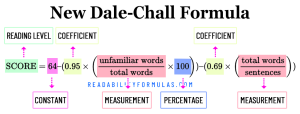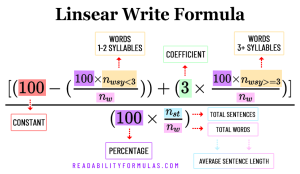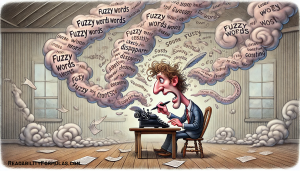 If we divide the term “readability” into “read” + “ability” , it translates into the ability to read . Readability has nothing to do with either legibility or literacy. In fact, readability is more of a judgmental exercise for the targeted audience. George Klare (1963) [bio. – Wikipedia], a pioneer in the field of reading research, defined readability as “the ease of understanding or comprehension due to the style of writing.”
If we divide the term “readability” into “read” + “ability” , it translates into the ability to read . Readability has nothing to do with either legibility or literacy. In fact, readability is more of a judgmental exercise for the targeted audience. George Klare (1963) [bio. – Wikipedia], a pioneer in the field of reading research, defined readability as “the ease of understanding or comprehension due to the style of writing.”
Basically, readability measures a text’s accessibility:
- Is the language simple enough for the intended readers?
- Does the structure, vocabulary, and tone match their knowledge or interests?
But readability goes beyond understanding just the words on a page or screen. Readability also includes the flow, tone, and structure of the content.
We can score readability by using readability formulas. They are mathematical in nature; their aim is to measure the grade level a person needs to read and comprehend a text. Writers consider these formulas as simple, fast calculations to score read-ability , i.e., a text’s difficulty level .

Like similar readability formulas, the Flesch-Kincaid Grade Level scores text by analyzing sentences and word difficulty to yield a grade level.
Readability formulas are invaluable tools, especially in education, publishing, and digital content. They help “match” material to the intended audience, whether that’s for students, consumers, or professionals.
These formulas work by measuring certain “surface-level” features of a text, like the number of words in a sentence, or the number of letters or syllables per word. Most formulas use a semantic factor (i.e., the difficulty of words), and one syntactic factor (i.e., the difficulty of sentences). We don’t need to calculate other factors, as they’ll make the formulas more complex and achieve little in return.
Let’s face it: writing any type of text takes time and effort. This text may be unique in its contents, yet fails to serve its purpose: helping the reader understand and use it. The problem many writers face is how to score readability. These formulas are the solution.
Researchers and writers have been using readability formulas since the 1920s; pioneering linguists like Rudolph Flesch and Jeanne S. Chall have spent decades of research devising the most accurate formulas.
The formulas used today include:
1. Rudolph Flesch’s Reading Ease Formula
2. J. Peter Kinkaid’s Flesch-Kinkaid Index
3. Robert Gunning’s Fog Index
4. The SMOG Readability Formula
5. Dr. Edward Fry’s Fry Graph
6. Raygor Readability Graph
7. The New Dale-Chall formula
8. The Fry Sight Readability Formula
9. FORCAST readability formula
10. Spache readability formula
11. Coleman-Liau Index
12. Linsear Write Readability Formula
13. Automated Readability Index (ARI)
Rudolph Flesch, the pioneer behind the Reading Ease Formula, believed that, “A readable writing needs no diagramming.”
By this, he meant clear and accessible writing was naturally easy to understand. His formula uses the total words, sentences, and syllables to yield a score between 0 and 100. The higher the score, the easier the text is to read. Popular magazines and consumer news websites often score between 60 to 70.
Robert Gunning, the developer of the FOG Index, was keen on eliminating “fog” from texts, which he described as “the murkiness that stands between the message and the reader.”
The Fog Index scores readability based on the average number of words per sentence and the percentage of complex words. A score of 12 is the reading level equivalent to a U.S. high school senior.
Readability formulas are used extensively in education and publishing; however, they have some downsides.
- Syntactics/Semantics: Most formulas, like the Flesch-Kincaid and Gunning Fog, use sentence length and word complexity. While these elements are important, they do not score the text’s overall complexity. Other factors, such as text coherence, logical progression of ideas, and cultural references, are ignored.
- Non-Linear Texts: These formulas work best on linear narrative texts; not so much on poetry, dialogue, lab reports, interviews, resumes, diagrams, or other non-standard texts. (Read more: When Should I Use Readability Formulas)
- Lack of Nuance: A score might suggest two texts are equally difficult, but readers might find one more challenging due to unfamiliar concepts, cultural nuances, or complex topics.
- Manipulation: Writers can adjust their content to achieve a certain readability score without simplifying their material. For example, a writer could use shorter sentences without improving the content’s clarity.
- Cultural Bias: Vocabulary and sentence structure influence a text’s difficulty across different cultures and languages. A formula to score English texts might not translate accurately to other languages.
- The Reader: Two readers with the same reading skills but with different experiences can find the same text easy or difficult, respectively. Readability formulas do not consider the reader’s prior knowledge.
- Usability: Text features such as headings, bullets, graphics, and layout can influence comprehension. Most formulas do not score text usability.
- Precision: A numeric score might give a false sense of objectivity and precision. Just because a text scores a “8.5” doesn’t mean it’s precisely appropriate for all 8th-grade students.
Readability formulas are rough gauges, but sometimes writers treat them as exact measures of text difficulty, leading to potential misapplications.
Despite these shortcomings, these formulas have advantages.
Healthcare and Medical Prescriptions:
Example: The Veteran’s Affairs (VA) medical centers undertook a project to simplify their patient education materials. After revising their documents with guidance from readability formulas, they improved patient comprehension. The result: fewer potential medication errors and better compliance to medical instructions.
Legal Documents:
Example: Many U.S. state governments require insurers draft policies at a specific reading grade level (often 8th or 9th grade). This ensures consumers understand their rights, obligations, and coverage. Insurers use readability formulas to confirm their policies’ target audience.
Education:
Example: Educational publishers like Pearson and McGraw-Hill use readability formulas to develop textbooks for lower-grade levels.
Aerospace:
Example: Because passengers often misunderstand safety cards, several airlines revisited the readability of their safety instructions. By making the text and illustrations clearer and easier to understand, they improved passengers’ ability to follow safety procedures in emergencies.
Government Communications:
Example: The Internal Revenue Service (IRS) used readability formulas to revamp their public-facing documents—they made them more accessible and reduced misunderstandings about tax obligations.
Technology and Software:
Example: Microsoft uses readability formulas to ensure public consumers understand their help guides and prompts. This minimizes user errors and reduces the burden on customer support.
Marketing:
Example: A popular online shoe retailer noticed their product return rate was high. Readability formulas helped simplify the language around sizing issues; this resulted in reduced product returns.
Web Content:
Example: GOV.uk, the British government’s public website, underwent a massive redesign with an emphasis on plain language and readability. Rewriting their text to target a public readership reduced the call volume and inquiries to government offices, as the public could more easily find and understand the information they needed online.
Finance:
Example: Many banks have started simplifying the language in their loan agreements and terms of service after realizing customers struggled to understand their financial commitments. Readability formulas helped make these critical documents more accessible to the general public.
Consumer Products:
Example: A popular home appliance brand noticed frequent misuse of one of its products due to users not following the instruction manual. They revised the manual using readability guidelines, which resulted in fewer user errors and returns.
Readability isn’t just about making content easier to read; it’s about ensuring your information is accessible, understandable, and usable for everyone.
Scott, Brian. “What Are Readability Formulas and Why Use Them?.” ReadabilityFormulas.com, 22 Jan. 2025, https://readabilityformulas.com/what-are-readability-formulas/.









